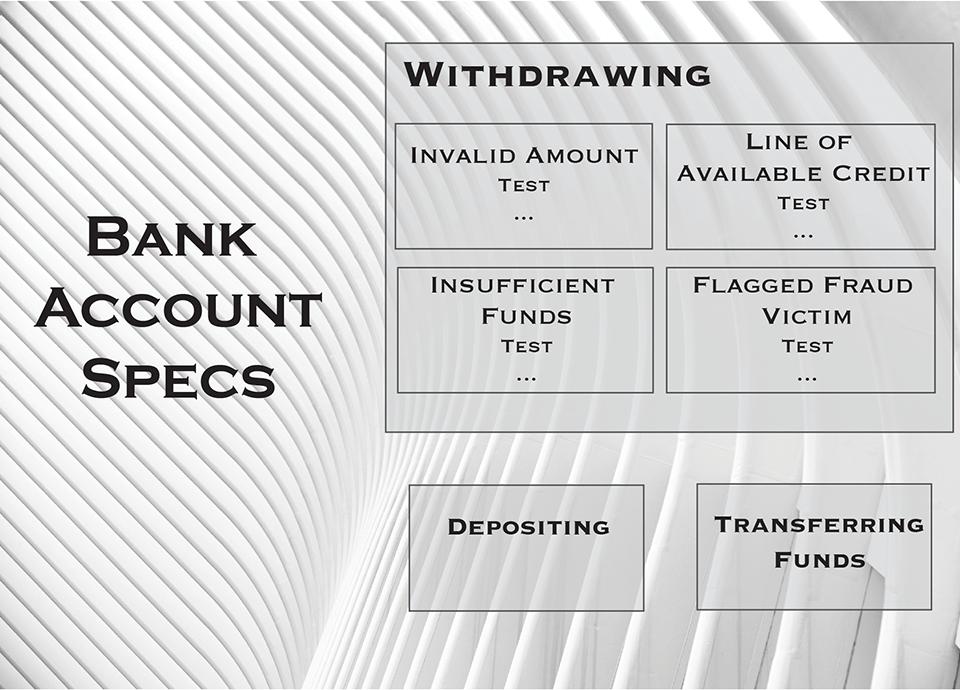He shows the tests to his co-workers, explaining that the tests live in a test fixture file. Each test is organized following the “arrange-act-assert” (aka, AAA) template. Facial expressions show concern as they see hundreds of lines of code in the file; way more lines of code than the actual class under test. “That’s a lot of effort,” one person says, "and I'm afraid the boss will think so, too."
Weeks later, a defect is found. The fix is easy; a simple if-block will take care of things. But Mr. Testa'lot Moore has learned that we're supposed to first write a unit test that reproduces the defect. He navigates through the long test fixture trying to find one that looks like a good starting point for the new test. That turns out to be a difficult task since several tests look awfully similar. He settles on one of them and takes a copy-and-paste approach, and proceeds to make adjustments so it reproduces the defect reported. By the time he's done, he looks at the code changes and notices that there are 50 new lines of test code for the one line of implementation code (a simple use of the ternary operator did the trick).
The time taken to turn around a fix to the defect was noticed by both teammates and the boss, who called her developer into her office to have a little talk, telling him not to waste that kind of time in the future. After that strike, the developer has to stop his newly-found practice, so now Mr. Don Testa'lot Moore questions his confidence in delivering code without proper automated tests. To his relief, a mentor enters his life and provides the guidance he needs.
This is what Don hears from his mentor...
Let's take that BankAccount class, for which you said you wrote many tests. You have a test fixture file named BankAccountTests, which contains all the tests for that class. I see almost 1,000 lines of code in there. The BankAccount class has several methods, including Deposit, Withdraw, and TransferFunds. The fixture includes at least one test for each method, and most methods require multiple tests to verify the different branches that are hit-based on parameters passed in. There are also tests that verify exceptional cases.

The first step to improve these tests is to organize the fixture by grouping the tests for the same methods, so we can see all of the tests for the Deposit method together, as well as for Withdraw, TransferFunds, etc.
Next, create a BankAccountSpecs folder (yes, let's start thinking of those things as specs, instead of tests). Move the BankAccountTests file in there.
Now, create one file for each method that you're testing. Simply copy the BankAccountTests file and paste it as many times as needed. A good way to name those files is Depositing, Withdrawing, TransferringFunds, and so on. Get in each file and remove all tests that are not the ones for the respective method under test.

That change alone already yields benefits. The next time you have to do something to the BankAccount class in the context of depositing, you'll be able to focus only on the tests in that area.
Moving on, let's pick one of those contexts. Say, Depositing, since we just mentioned it. Look at the arrange section of each test in there. Identify what they have in common. Find code that looks exactly the same in some tests. Extract such code into separate methods and reuse it in all tests. Find code that looks mostly the same, except for minor things (maybe there's a true value here and a false there). Extract those lines into a separate method, turn those variable values into parameters, and reuse the method where applicable. Follow the same process with the act and assert sections of each test. The file should have far fewer lines of code now and each test should be much more palatable! Do the same to the test files for the other methods.
When all the test files have been cleaned up, go through them, look at the methods you created to handle the arrange, act, and assert sections, find out methods that look exactly the same across all files, cut them out of there, and paste them in a brand-new file, named BankAccountSpecsBase (or something like that). Guess what? Yup, reuse the code in your spec files! If those are written in a language that supports inheritance (C#, TypeScript, Java), you just got a base class for your BankAccount specs. In languages that don't support inheritance, you just got a module, or whatever mechanism is at your disposal to reuse code.
Keep going through those files and identify any other code that can be used across specs. At the end of this process, you'll have a better understanding of things. For example, you may find out that the BankAccount class is always instantiated the exact same way. Or, maybe it is instantiated the same way based on what method is being called on it (such as initialized with an initial balance of $0 when testing the Deposit method, and an initial balance of $1000 on tests for the Withdraw method).
At this point, take a look at each spec file again. Let's revisit withdrawing, for example. Look through its tests and see if there's any redundant code across them. Right now, anything left in there should be specific to withdrawing. There may be still a dozen tests in the file. Can you guess what's coming next? Create a folder named withdrawing and move the spec file in there. Identify which tests have similar arrange sections; those are specific contexts in which withdraws happen. Group them together, move them into separate files named after the context (for instance, "invalid amount", "insufficient funds", "line of credit available", "flagged fraud victim"). Look through those files, identify any common code, pull it out, and paste it into a new file, named WithdrawingContext (or something along those lines).

What do we get out of this approach?
Spec files that are very small and easy to grasp;
The organization by context makes it easier to find the specs as needed (
"hmm, a defect was found when withdrawing money from a bank account that has been flagged as a victim of fraud. I know exactly how to immediately find the tests in that area!" );
Writing new specs become much easier because there's a lot of "test code" that can be reused;
From here on, new specs for any area are written with this thought process in mind (
"What are the scenarios? What are the contexts? How are they either similar or different?");
When changes are made to the code and tests fail, it's now quicker to see the features and scenarios impacted by the changes;
The approach works regardless of the type of tests (unit, integration, end-to-end) part of the software (front end, back end), test frameworks, and runners (MS-Test, NUnit, JUnit, xUnit, Jest, Jasmine, Cypress.io...);
Tests won't rot and get abandoned since they're now clean, well-organized, and easier to maintain.
After this experience of enlightenment with his mentor, Don decides to drop his first name and now only goes by Mr. Testa'lot!




